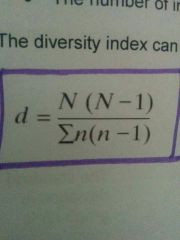![]()
![]()
![]()
Use LEFT and RIGHT arrow keys to navigate between flashcards;
Use UP and DOWN arrow keys to flip the card;
H to show hint;
A reads text to speech;
20 Cards in this Set
- Front
- Back
|
Ecosystem |
Natural unit consisting of living organisms (biotic: flora and fauna), their interactions with each other and the non-living (abiotic) components of the habitat. |
|
|
Populations |
Groups of organisms of the same species occupying the same habitat at the same time |
|
|
Communities |
Different populations found in a particular habitat, based upon dynamic feeding relationships between different species. |
|
|
Species |
Organisms with similar characteristics that can interbreed to produce fertile offspring. They have similar DNA and share the same ecological niche |
|
|
An organism's niche |
The particular role of an organism wihin an ecosystem, governed by its adaptation to the food supply (and thus it's feeding role), the habitat it occupies and the abiotic factors present. No two species share the exact same niche. |
|
|
Biotic factors in an ecosystem |
Living organisms. Include: producers (autotrophs), consumers (heterotrophs, can be primary, secondary and so on), saprobionts (bacteria and funghi that bread down dead organisms) and detritivores (organisms that feed in detritus, dead decaying matter) |
|
|
Abiotic factors in a ecosystem |
Physical aspects of the ecosystem on which organisms depend: light (often limiting factor in photosynthesis), pH, temperature (affects enzymic reactions and biodiversity) |
|
|
Gross primary productivity (GPP) |
Gross photosynthesis. Total amount of light energy converted to chemical energy in photosynthesis. |
|
|
Net primary productivity (NPP) |
Net photosynthesis. Amount of energy from photosynthesis still available to primary consumers. I.e. GPP minus respiratory loss |
|
|
Density dependent factors affecting population stability |
Tend to be biotic factors such as disease, competition and parasitism. Factors that intensify when population density is high. |
|
|
Density independent factors affecting population stability |
Tend to be abiotic factors such as earthquakes, fires, floods, draughts. Factors that affect the population regardless of population density. |
|
|
Interspecific competition |
Competition between different species. For plants, different species compete for soil minerals, light and water. For animals, different species may compete for the same prey, water supply or nesting site. |
|
|
Competitive exclusion principle |
No two species can occupy precisely the same niche so they never compete for exactly the same resources |
|
|
Intraspecific competition |
Competition within a species for food sources, mates etc. Competition is more intense because organisms are in the same niche and therefore are competing for identical resources |
|
|
Predation |
Type of interspecific interaction. Important in controlling population sizes. The larger than prey population, the the larger the predator becomes. As prey are consumed, prey population size falls so predator population also falls |
|
|
Biodiversity |
Variety of organisms occupying a particular habitat |
|
|
Species richness |
Measure of number of different species in a community |
|
|
Diversity index |

Numerical expression of species diversity. The higher the value of the diversity index, the greater the species diversity of the community. |
|
|
Monoculture farming |
Growing same crop on same land year after year |
|
|
Impact of monoculture on environment |
Loss of hedgerows, soil erosion from increased exposure to wind, reduction in species diversity, increased risk of species-specific pests on crops, increased use of fertiliser leads to leaching and eutrophication, impact of herbicides and pesticides |

